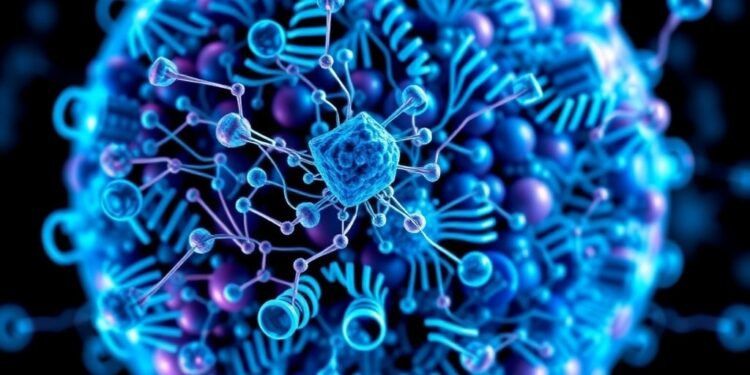Researchers have unveiled the intricate and dynamic landscape of ribosomal RNA (rRNA) modifications across tissues, developmental stages, and disease states. Their study introduces “epitranscriptomic fingerprinting,” a revolutionary approach capable of identifying tissue origins and tumor states with unparalleled precision. This method leverages the potential of direct RNA sequencing (DRS) to decode the molecular imprints of rRNA modifications, promising transformative applications in cancer diagnostics and personalized medicine.
For decades, ribosomes, the cellular machines responsible for protein synthesis, were perceived as static structures, their components identical across cell types and conditions. However, recent findings have challenged this dogma, revealing that ribosomes exhibit remarkable heterogeneity. At the core of this heterogeneity lies the epitranscriptomic modification of rRNA—an intricate layer of biochemical changes that decorate rRNA molecules, influencing their structure and function. With over 220 known modifications, including pseudouridylation (Ψ) and ribose methylation (Nm), these modifications play critical roles in cellular processes, from ensuring protein synthesis fidelity to responding to environmental changes.
The new study, spearheaded by Eva Maria Novoa and her team, has charted this unexplored territory using DRS technology. Unlike traditional sequencing methods, which require reverse transcription and lose contextual information, DRS directly sequences native RNA molecules. This allows researchers to capture the full spectrum of RNA modifications in their natural context. Applying DRS, the team systematically mapped rRNA modifications in mouse and human samples across various tissues, developmental stages, and disease states, including cancer.
One of the study’s most striking discoveries is the ability to classify tissues and developmental stages based solely on rRNA modification patterns. For instance, the team identified unique modification signatures in mouse brain, heart, liver, and testis tissues. These signatures were not static; they evolved dynamically across embryonic, neonatal, and adult stages. Intriguingly, 14 of the 31 differentially modified sites identified had not been previously annotated, underscoring the importance of this agnostic approach.
To validate their findings, the researchers employed orthogonal techniques, confirming that many of these novel sites were pseudouridylated residues. They also linked specific modifications to the activity of small nucleolar RNAs (snoRNAs), which guide the deposition of rRNA modifications. For example, the study demonstrated that the snoRNA Snord90 is responsible for guiding methylation at a key site, 18S:Um355, a modification associated with cellular proliferation potential.
Building on these insights, the researchers turned their attention to cancer. By analyzing matched normal and tumor samples from human lung, colon, testis, and liver tissues, they uncovered distinct rRNA modification patterns that differentiate healthy and cancerous states. Notably, lung and testicular tumors exhibited the most pronounced differences. These findings highlight the potential of rRNA modifications as biomarkers for early cancer detection. Using a machine learning classifier trained on rRNA modification data, the team achieved an impressive 97% accuracy in distinguishing tumor samples from as few as 250 sequencing reads per sample. This efficiency opens the door to cost-effective diagnostic applications, especially in clinical settings.
The implications of these findings extend beyond cancer. Epitranscriptomic fingerprinting could revolutionize tissue deconvolution, a critical challenge in fields ranging from developmental biology to forensic science. By leveraging the unique modification signatures of rRNA, researchers can pinpoint the tissue of origin for a given sample with unprecedented accuracy.
While the study represents a significant leap forward, it also raises intriguing questions. The mechanisms underlying the observed rRNA modification diversity remain elusive. Differential expression of snoRNAs does not fully explain the tissue-specific patterns, suggesting the involvement of yet-to-be-identified regulatory factors. Additionally, the functional consequences of these modifications are not entirely understood. Do they influence ribosomal specialization, enabling selective translation of specific mRNAs? Or do they serve as markers of cellular states, reflecting broader physiological changes?
Future research aims to address these questions, exploring the interplay between rRNA modifications, cellular function, and disease. Expanding the scope of this work to include other cancer types and larger cohorts will further validate the diagnostic potential of epitranscriptomic fingerprinting. Moreover, the integration of this approach with other molecular profiling techniques could provide a holistic view of cellular states, enhancing our understanding of complex biological systems.
As the field of epitranscriptomics advances, the high abundance of rRNA molecules, traditionally considered a nuisance in sequencing experiments, emerges as a major strength. The ability to extract meaningful biological information from these molecules paves the way for innovative diagnostic and therapeutic strategies. From early cancer detection to guiding surgical decisions, epitranscriptomic fingerprinting holds the promise of transforming healthcare.
This pioneering study not only reshapes our understanding of ribosome biology but also sets the stage for a new era of precision medicine. By unraveling the hidden code in rRNA, researchers are unlocking a wealth of diagnostic and therapeutic possibilities, charting a path toward a future where diseases are detected and treated with unparalleled accuracy.
Subject of Research: Ribosomal RNA modifications and their potential as diagnostic biomarkers.
Article Title : Epitranscriptomic rRNA Fingerprinting Reveals Tissue-of-Origin and Tumor-Specific Signatures.
News Publication Date : January 2, 2025.
Article References : Milenkovic, I., Cruciani, S., Llovera, L., Lucas, M. C., Medina, R., Pauli, C., … & Novoa, E. M. (2025). Epitranscriptomic rRNA fingerprinting reveals tissue-of-origin and tumor-specific signatures. Molecular Cell, 85(1), 177-190.
Image Credits : Scienmag
Keywords : RNA modifications, epitranscriptome, rRNA, fingerprinting, classification, cancer, nanopore sequencing, pseudouridine.





